Under the cover of a standard medieval romance, Chaucer’s Knight’s Tale is a grim and astrologically-rich contemplation of human passion, fortune, and destiny. This article ponders the purposes of the Knight’s Tale’s uses of astrology and astrological symbolism in the context of these larger issues. Why do gods and humans take on qualities of astrology’s planets? Why is so much timing for the action according to planetary hours and days? Of particular note is the poet’s presentation of “Duc” Theseus and his planetary symbolism. These issues also allow us to understand better the tie between the Tale and its narrator.
What the Miller Heard
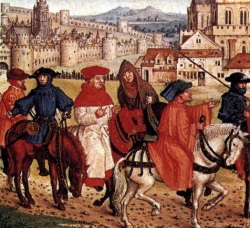 The Knight’s Tale is one of the more enigmatic of Chaucer’s Canterbury Tales, is awash with astrological symbolism, and has astrology itself as a major concern. Its astrological content, in light of the story itself and its depictions of the main characters of the Tale (and especially its central character, Duke Theseus), helps us understand the Tale, the Knight and the position of tale and teller within the larger poem.
The Knight’s Tale is one of the more enigmatic of Chaucer’s Canterbury Tales, is awash with astrological symbolism, and has astrology itself as a major concern. Its astrological content, in light of the story itself and its depictions of the main characters of the Tale (and especially its central character, Duke Theseus), helps us understand the Tale, the Knight and the position of tale and teller within the larger poem.
The Knight’s Tale has the form of a romance – a story for the aristocracy in which virtue and nobility triumph over adversity, a tale that supposedly demonstrates the code of conduct for Chaucer’s warrior class.[1] The Tale is also a solemn Boethian contemplation of fortune, necessity, and providence; its consideration of astrology is inseparable from these issues.
To the modern reader, the Knight’s Tale is not as well-known as the following one that “quits” (requites) it, the Miller’s Tale. Chaucer’s modern readers tend to hear the Knight’s Tale through the Miller’s ears, as haughty upper-class fable by and for an aristocratic audience.
Yet the Knight’s Tale is filled with uncertainty and incompleteness. On closer examination it is an anti-theodicy: story and narrator raise concerns about the goodness of the world and whether there is a good God above. Yet, the Miller, who cares not a bit about God’s justice or questions of destiny and chance, indirectly may have the last word.
Chaucer sets the stage by first describing the Knight in the General Prologue, (43-78).[2] As the highest-ranking member of the group travelling to Canterbury, the Knight’s fine qualities are given first and thus headlined. He is a “worthy man”, one who loved chivalry (knightly skill), honor, “freedom” (generosity), and “curteisye” (refined manners): he was “a verray parfit gentil knight” (l. 72). The Knight’s Prologue refers to many campaigns in which he participated, taking him to Egypt, Prussia, Lithuania, and Algeria. All these campaigns had served religious purposes, and none were very successful.[3] Notably the Knight never crossed the Channel to participate in the more secular Hundred Years’ War.
Neither Knight nor his horse was in robust condition to begin the pilgrimage to Canterbury: the horse “was good but not gay” and the Knight’s clothing was worn and stained: “For he was late y-come from his viagge (voyage)/ and wente for to doon his pilgrimage.” (77-78) The Knight had just returned from war and immediately joined the pilgrimage.
I think of Chaucer’s Knight as a recently-returned war veteran, man disillusioned by having seen too much of war and the world. The Knight wins the draw for who is to tell the first story and he begins immediately. There is no time for preparation and no opportunity to make his presentation more institutionally correct.
After recounting his story and some of its astrological content, we will attend to Chaucer’s depictions of the astrological planets. As we move from the two rivals and their shared object of affection, to the gods of Olympus, and finally to Theseus himself, we will see how Chaucer conceived of the individual planets but also the constraining quality of their influence.
The Surface Romance of the Knight’s Tale
Chaucer based the story on a larger and more cheerful presentation by Boccaccio, the Teseida. Chaucer’s Tale departs in many revealing ways from Boccaccio’s work and takes its bleak atmosphere more from the Thebiad, a Roman epic by Statius that Chaucer knew well and was a source for Boccaccio.[4]
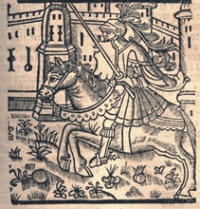 The Latin quote at the top of the text of The Knight’s Tale is from Statius’ epic poem: “After his bitter wars in Scythia, Theseus drove his laurelled chariot back to his native country.” (Book XII, 519-521) [5] Its action begins then, after Theseus, Duke of Athens, has defeated the Amazons. He has taken its queen Ipolita as his wife and, along with Ipolita and her sister Emelye, was returning to Athens in triumph.
The Latin quote at the top of the text of The Knight’s Tale is from Statius’ epic poem: “After his bitter wars in Scythia, Theseus drove his laurelled chariot back to his native country.” (Book XII, 519-521) [5] Its action begins then, after Theseus, Duke of Athens, has defeated the Amazons. He has taken its queen Ipolita as his wife and, along with Ipolita and her sister Emelye, was returning to Athens in triumph.
Near the gates of Athens, Theseus and his entourage encounter a group of unhappy women in dark mourning garb, one of whom grabs his bridle. They tell of Creon, King of Thebes, who has decreed that the bodies of their husbands, soldiers killed in their attack on the city, be left unburied. Outraged and moved by the plight of these women, Theseus immediately turns his soldiers around to march on Thebes. Theseus kills Creon in single combat and his troops take the city.
Theseus’ soldiers find two noble cousins, Arcite and Palamon, lying among a pile of corpses of the Theban dead. Theseus decrees that the two men be imprisoned in Athens indefinitely and without hope of ransom. Arcite is associated with Mars, Palamon with Venus.
They spend several years languishing in that prison tower that overlooks a garden. On one morning in May, Palamon glimpses the fair Emilye from the window and does not know whether she is woman or a goddess.[6] Arcite sees Emilye and is pierced by the sight of her, and he also swears eternal devotion to her. The two men quarrel.
At the request of an old friend, Arcite is set free by Theseus, but on the condition that he does not return to Athens on pain of death. Back in Thebes, deprived of the sight of fair Emilye, Arcite becomes ill with the dark choler (associated with Saturn), until the god Mercury tells him to return to Athens. Arcite’s appearance was so changed by his ailment that he is unrecognized in Athens and he assumed a new identity. He finds work as a laborer, begins to work for Emilye’s household, rises in stature and eventually is knighted by Theseus himself.
Finally, years after his cousin’s release, Palamon escapes from jail. He flees Athens and hides in a grove outside the city. It is a Friday morning, the day of Venus.
“By aventure” (closer to our word ‘accident’), Palamon in the bushes overhears a nearby knight talking with himself, painfully retelling how he is forever wounded by Emilye – it is heartsick Arcite. Palamon jumps out of the bushes and confronts his cousin. They agree to fight to the death the following day, and Arcite returns that day with armor and weapons for his cousin.
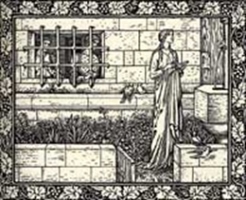 On this day – a Saturday and thus governed by the planet Saturn — the two men begin their battle. They fight all day. But accident or destiny or chance closes in again: in a coincidence that could not happen within a thousand years (l. 811), riding in a hunt is Duke Theseus, his wife and Emilye and others, and they happen onto the same grove.
On this day – a Saturday and thus governed by the planet Saturn — the two men begin their battle. They fight all day. But accident or destiny or chance closes in again: in a coincidence that could not happen within a thousand years (l. 811), riding in a hunt is Duke Theseus, his wife and Emilye and others, and they happen onto the same grove.
Theseus stops the fight. When Palamon tells Theseus who they are and about both their love for Emilye, the angry Duke, invoking Mars, decrees that they be executed immediately. Suddenly he is interrupted by the weeping of the women who beg for mercy for the two noble men. Theseus calms down, remembers his own youthful follies of love, and devises a solution. Theseus decrees that in one year Palamon and Arcite will return with a hundred fellow knights each. They will have a great tournament battle and whoever is judged the winner will marry Emilye. In this form of “judicial combat”, the conflict between the two men has been transformed into state ritual; in contemporary Freudian terms, this solution is an attempt at cultural sublimation of instinct. It also moves from the personal to the iconographic, one could even say “archetypal”.[7]
In the intervening year, Theseus has had built a gigantic amphitheater for the contest. Above the gates are temples for Venus in the east, Mars in the west, and Moon/Diana in the north. The southern gate is for him and his entourage. Exactly one year after their duel in the grove, Palamon and Arcite return to Athens with their one hundred knights each.
In the third hour before dawn on Monday – in the hour of Venus – Palamon visits the temple of Venus to pray and make sacrifices.[8] Palamon makes supplication to the goddess: he is not concerned with the winner or loser of this fight, or any share of fame or glory, but only that the goddess give him his love Emilye. The statue shakes and makes a sign, meaning to Palamon that she gives consent to his desire.
At sunrise, on the Moon’s day and hour, Emilye makes supplications and offerings to the Goddess Diana, the Goddess of the Moon and the hunt. Emilye wishes to know no man but remain devoted to the goddess Diana. However, the answer from the goddess is that Emilye is destined to marry one of these two men but the goddess cannot say which one.
In the first Mars hour of that day, (the fourth hour of the day) Arcite visits the temple of Mars to make his offerings and supplications. Arcite wants to win Emilye; he will do the work and the god Mars will get the glory and praise. He asks that he win the battle the next day and the statue answers with a dim murmur: “Victorie!”
In Heaven among the gods, Venus is upset that Mars has promised Arcite victory. Jupiter is unable to work a deal between the two, but Saturn has a solution and promises that Arcite will have his victory and Palamon will marry Emilye.
It is Tuesday morning, the day that belongs to Mars. Palamon and his knights enter from the east, under the temple of Venus; Arcite and his men enter west under the temple of Mars. The two sides fight vigorously all day, the two knights particularly fiercely, but at the end of the day Palamon is defeated and he is dragged by twenty men from the field. Theseus proclaims Arcite victorious and the winner of Emilye.
 However, before sunset on Tuesdays and on the planetary hour that belongs to Saturn, the god intervenes.[9] As Arcite is taking his victory lap, a Fury bursts from the ground and startles Arcite’s horse, the knight falls and, in the manner of Mars once again, Arcite receives an injury to his head and a few days later he dies. The funeral for the fallen knight is grand and solemn (and overblown in its telling), and Palamon returns to Thebes.
However, before sunset on Tuesdays and on the planetary hour that belongs to Saturn, the god intervenes.[9] As Arcite is taking his victory lap, a Fury bursts from the ground and startles Arcite’s horse, the knight falls and, in the manner of Mars once again, Arcite receives an injury to his head and a few days later he dies. The funeral for the fallen knight is grand and solemn (and overblown in its telling), and Palamon returns to Thebes.
Several years later the issue is no longer war but the need for alliance between Athens and Thebes. Theseus summons Palamon back to Athens and Emilye to court. At the end of a long speech we will later examine, the Duc decrees that to cement further ties between the two cities and “to maken a virtu of necessitee”, Emilye and Palamon will wed. This comes about and the two live happily ever after.
The modern reader, coming to this story for the first time, will have a few immediate responses. One might be alarmed at the muted rule of Emilye, the object of the two men’s blind affections. Chaucer’s reduction of Emilye’s role is noteworthy and very different from Boccaccio’s text: Boccaccio’s Emilye notices the two men looking at her and she is flattered by their attention. As Arcite appears to have won the tournament, Emilye is shown to have fallen in love with him. Chaucer’s Emilye is deliberately left blank.
We also note the prominent role of coincidence. What seems accidental is not; instead, seemingly-random events are derived from “destinee” that is the outflow of divine providence. Destiny or providence occurs through the configurations and motions of the planets that are God’s instruments for this purpose.[10] The turnings of Fortune’s wheel for humans are not predicated on the whimsy of the gods but are instead God’s intentions, delegated to the planets. The many references to “aventure or case (chance)” are instances of stellar influence with providential intention. To this Chaucer adds a profound pessimism.
We may also recall the medieval view that astrological causation operates in the spheres of the material world and our bodies and emotions, but the intelligent soul can rise above stellar influence and exercise free will[11]. The action of the Knight’s Tale displays the unhappy flow of planetary influence upon the world below and accords with the Tale’s sense of the futility of all earthly concerns. To what extent we can rise above our corruptible natures that are governed by the stars? This is an urgent concern for the weary Knight and for the poet himself.
People, Gods, and Planets
Let’s now look at this same story from the viewpoint of its astrological symbolism.
At the beginning of the Knight’s Tale,Chaucer does not portray Arcite and Palamon in any way that would distinguish them from each other, but this does not last for long. We begin to see their differences, and the differences between Venus and Mars, in their initial quarrel about their respective passions for Emilye.
On that fateful morning in May Palamon first glimpses Emilye and is immediately taken over by the experience. He cries out and Arcite hears him. Not understanding the cause of Palamon’s cry, Arcite asks Palamon to be patient with his fate. We must submit to the grim dictates of necessity, one that has been determined astrologically:
Fortune that yeven us this adversitee.
Some wikke aspect or disposicioun
Of Saturn, by sum constellacioun,
Hath yeven us this, al-though we hadde it sworn;
So stood the heven whan we were born. (228-232)
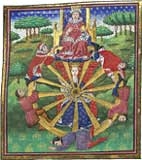 Palamon then tells Arcite about seeing Emilye but not knowing whether she is a person or the goddess Venus herself. Arcite takes a look for himself and suddenly he too is wounded (one could say “smitten”) by the sight of her. “I nam but deed”, he says.
Palamon then tells Arcite about seeing Emilye but not knowing whether she is a person or the goddess Venus herself. Arcite takes a look for himself and suddenly he too is wounded (one could say “smitten”) by the sight of her. “I nam but deed”, he says.
In an angry response, Palamon calls his cousin a “traytour”, citing their previous oath that gave them the status of brothers. Since Palamon has seen Emilye first and has taken her as ‘his lady”, Arcite was duty-bound to help him attain what he desires, not to be a rival for them. Palamon’s blatantly self-serving argument stresses social ties, a focus for the astrological Venus.
Mars-like Arcite will have none of this. He first accuses Palamon of not being legitimately in love but having instead an “affeccioun of holynesse”, since Palamon was unclear whether he had fallen in love with a goddess or a human. In the more worldly Mars-like fashion, Arcite states, “and myn is love, as to a creature.” (l. 301) He then argues against the legitimacy of the bond Palamon had invoked: love is a force that is stronger than the bonds of oath, since once under love’s spell one is powerless over the quieter voices of reason. After reminding Palamon that each man’s situation is utterly hopeless, Arcite invokes a wholly Martian principle: “Ech man for him-self, ther is none other.” (l. 324)
At this time the two knights were confined to prison and suffered through the decree of Theseus. Having been afflicted by the beauty of this young woman, the two men were now confined by and suffer from their instincts or passions.[12] The minds and bodies of both men have been hijacked by their responses to Emilye that causes both to suffer greatly – in her presence or in her absence. Following the medieval notion that the planets are responsible for bodies and instincts, both men are at the mercy of their governing planets.
Arcite, when freed from prison, is yet no happier for his release.
He seyde, ‘Allas that day that I was born!
How is my prisoun worse than biforn;
Now is me shape eternally to dwelle
Nought in purgatorie, but in helle…” (365-368)
Then we find bodily manifestations of Saturn. Back in Thebes, Arcite’s eyes have become hollow, he is unable to sleep, drink, or eat, and he turns pale and he continually weeps; this is not the standard illness of the heroic lover, “…but rather lyk manie (mania)/Engendred of humour melancholyk/ in his celle fantastyk (the part of the brain where imagination resides). (516-518). The melancholic humor is, of course, associated with Saturn.
Later, after the tournament, we also find Saturn afflicting Arcite bodily (ll. 1885-1899): in the days after the fall from his horse after the tournament, clotted blood had became corrupted and would not exit his body; no medical remedy, particularly emetics and laxatives, would be any help.
Do Arcite’s sufferings imply a primordial battle between malefics Mars and Saturn? Walter Curry maintains that “the real conflict behind the surface action of the story is a conflict between the planets, Saturn and Mars.”[13] Indeed the two malefics hardly have room for one another. The nature of our world may be best depicted by the ongoing competitive influence of Mars and Saturn. In my view Curry’s thesis accounts for much but doesn’t sufficiently explain the role of astrological qualities in this Tale.
We see symbolism of Venus and Mars for our two heroes during their first confrontation in the grove. Palamon, who has just escaped from the prison, is hiding in the bushes and hears Arcite’s declarations of bitter love. Palamon angrily jumps out of the bushes and proclaims, “Thou shalt nat love my lady Emelye,/But I wol love hire oonly and namo;/ For I am Palamon, thy mortal foo”(723-725). Palamon, focused solely on obtaining the object of his desire, has ignored the fact that he is unarmed and facing one far more ready and able to fight. Arcite obliged in the manner of Mars by taking out his sword and threatening to kill him, but he does not. Perhaps in a redemptive move we will see more of later, Arcite proposes that they fight as equals the next morning and Palamon agrees.
The next morning they meet and help each other put on their armor and they fight savagely for most of the day. There is no evidence that Venus-like Palamon is any less strong or fierce than his Mars-like cousin. Anticipating the tournament battle one year later, Palamon and Arcite are depicted as animals fighting fiercely and they become ankle-deep in blood. This is no noble battle but two people savagely attempting to destroy each other. They are rivals and hold to two different planets but they are the same in their common unrestrained nature, their inability to be rational.
Chaucer has given us a grim picture of the world as influenced by astrology’s planets. This is further developed by the “temples” to the gods-planets that have been built above three gates of the massive stadium built for the tournament. In Boccaccio, the coliseum was already there, and the participants visit temples already within Athens.
Ordinarily temples contain images of positive features of their deities, since the function of a temple is for people to worship and make sacrifices to them. In Chaucer’s temples, all three gods-planets are rendered difficult and harmful and each temple captures something painful about the human condition. There is nothing ennobling or dignified about them.
If we think of Venus as the goddess of love and the astrological planet as the planet of love, we have portraits on the wall of the misery that accompanies romantic love, “pitous to biholde”.
The broken slepes, and the sykes (sighs) colde,
The sacred teres, and the waymenting (lamenting),
The fyry strokes of the desiring,
That loves servaunts in this life enduren… (1062-1065)
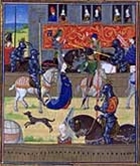 There are also paintings of famous heroes and their follies of love.
There are also paintings of famous heroes and their follies of love.
According to the medieval understanding of the astrological planets, Venus also governs all forms of pleasure and enjoyment. Venus’ temple contains illustrations of pleasure, beauty, youthfulness, charms, and richness, and also deceit, flattery, wasting money, and jealousy. Depicted are instruments of music and feasting, singing and dancing, clothing and adornment.
The goddess Venus is pictured naked, floating in a large sea, half-covered with waves. She holds a stringed instrument in one hand, on her head is a garland of roses, and doves fly above. Cupid stands just below with his arrow. In the context of its accompanying art, Venus is pleasing and seductive but dangerous.
On the other side is the temple of Mars that is outrageous, horrific. Chaucer gives more detail here, using eighty-four lines, whereby Venus was dispatched with a mere forty-nine.
The overall color of Mars’ temple is red, of course. The surrounding artwork includes a miserable forest with gnarled knotty trees and hideous bushes and a painting of a temple made of burnished steel with doors of adamantine rock. Accompanying portraits include illustrations of wickedness (“felonye”), fear, warfare, war, bad luck, and madness. We see portraits of tyrants and cities being destroyed. There is an act of suicide through one putting a nail through his head, a man run over by his own cart with his head trapped under the cart’s wheel, and a boar eating an infant in its cradle.
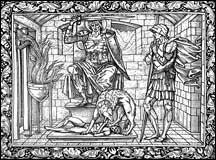 In the middle of this grim artwork are depictions of professions astrologically governed by Mars: the smith, butcher, and the barber; there is also mention of a scalded cook. These serve to remind the reader that Mars is the astrological planet and is the Olympian god only by literary convention.
In the middle of this grim artwork are depictions of professions astrologically governed by Mars: the smith, butcher, and the barber; there is also mention of a scalded cook. These serve to remind the reader that Mars is the astrological planet and is the Olympian god only by literary convention.
Mars is on a chariot looking grim and cold. A wolf is at Mars’ feet, looking at what is left of a person the wolf had just devoured. All these details reflect the mind of a man who, like Chaucer in his own life and the Knight of the Canterbury Tales, had witnessed the horrors of war.
The north and the temple for the goddess Diana (affiliated with the Moon) is only thirty-six lines. Diana was the ancient goddess of hunting who can be quite vindictive when displeased. Depicted are various transformations – Callisto who was changed into the stars Ursa Major, Daphne who was turned into a tree, and Actaeon who, when he was caught spying on the naked goddess bathing, was changed into a deer and devoured by his own dogs. The goddess herself is clothed in green and has hunting dogs at her feet; a nearly full Moon is below. Her gaze is toward the realm of Pluto, the Underworld.
This is not the psychologically-rendered Moon of modern astrology. Instead there is the quality of wildness; the concept of hunt is rich in meaning as a journey through darkness and the untamed nature of the forest. Another consideration is the act of transformation itself that corresponds to the medieval notion of the Moon as the planet of change. Diana’s “virginity” is not the sense of sexual purity as much as being unaffiliated with a man by marriage or any other formal (i.e. subordinate) relationship. Diana is outside the bounds of the social ties that prevailed in Chaucer’s time and carries its own possibilities of wildness. This is the Moon as the luminary of the night and, like Venus and Mars, can be also thought of as primordial and instinctual.
After the three visits to these temples, the action moves to the realm of Olympus. This is an important move by Chaucer.
Walter Curry remarks on the transformation of Olympian myth into medieval astrology. “In recasting the story for his medieval audience the artist has apparently found it necessary or perhaps expedient to discard much of the ancient mythological machinery, which would encumber the narrative to no purpose, and to substitute as a motivating force that formative and impelling influence of stars in which his age believed.”[14] In this context we can examine the “gods’” words and actions.
Having made promises to their respective champions, up high above Venus and Mars argue over the outcome of the tournament and who will prevail. “Iupiter was bisy it to stente” (1584) – Jupiter was busy trying to contain it – until Saturn intervened, asserting that he could resolve the matter. Saturn says he is the oldest, wisest, and is most powerful god – because of his widest orbit in heaven. Now Saturn the god becomes Saturn the planet.
This Saturn is not particularly wise but is instead grimly clever. Here are some of his attributes and influences:
Myn is the drenching in the see so wan;
Myn is the prison in the derke cote;
Myn is the strangling and hanging by the throte;
The murmure, and the cherles rebelling,
The groyning, and the pryve empoisoning:
I do vengeance and pleyn correccioun,
Whyl I dwelle in the signe of the leoun. (1598-1604)
Saturn continues, claiming governance over ruined halls, fallen towers and walls, treasons, the pillar that shook the Biblical Sampson. (In Chaucer’s depictions there is considerable overlap between the power and deeds of Mars and Saturn.) Finally, after mentioning cold sicknesses, Saturn boasts that he is the “fader of pestilence” – a major concern in Chaucer’s time. According to David Aers, this “drives home the absence of love and care towards humans in this world-order.”[15] Again, we need to consider not the Saturn of mythology but of astrology.
Now we can turn our attention to Theseus, the central character in The Knight’s Tale. What are his planetary attributes? Of the four directions on the Duke’s grand coliseum we have temples to Mars, Venus, and the Moon – and the Duke inhabits the southern gate. How does the Duke fit in with the Knight’s Tale’s planetary dynamic?
The Duke and the World
Throughout the Knight’s Tale, Duke Theseus embodies leadership. He is the reigning authority over all the action, and the arbiter of the destiny of the main character; he is the source of the tournament and its coliseum, and the decider of the Tale’s final outcome. He may be thought of like the monotheistic Christian God, the medieval view of a King, and like astrology’s Sun.
At the Tale’s outset it is said of Theseus “that greater there was noon under the sonne”, a successful conqueror and one with wisdom and chivalry (4-6). Theseus is also the only character in the Knight’s Tale who we see deliberating and who comes into conflict with himself.
There has been a critical tendency to idealize Theseus. To D. W. Robertson he is a wise Christian-like ruler who blends justice with mercy.[16] He is the force of reason, especially in contrast to the excesses of the two knightly rivals. He is considered the principle of order: he is, according to Charles Muscatline “representative of the highest chivalric conceptions of nobility” and “representative of fate on earth.”[17] On the other hand, David Aers likens Theseus to a promoter of state-sanctioned force and violence; to Jordi Marti, Theseus is a shallow and ineffective promoter of the virtues of knighthood.[18]
The idealized portrait of Theseus would be firmly in line with the Sun’s symbolism in medieval astrology. A review of the medieval view of astrology’s Sun sheds some light on the role if not the behavior of a reigning monarch like the Duke of Athens.
Guido Bonatti, a major source for the medieval tradition, notes the centrality of the Sun’s position within the other planets and the strength of his motion to account for its regal symbolism.
“… [the Sun] signifies light and splendor, and beauty, and intellect and faith. And he even signifies a great kingdom, and all other lay dignities, both of magnates and others. And this, because he is posited in the middle of the others (just like a king), and the others stand next to him – certain ones on one side, certain ones on the other side…Moreover his motion is most noble above the motions of the other planets, nor does he go retrograde like others go retrograde…” Treatise 3, Chapter 4 [19]
From the century before Bonatti, Ibn Ezra gives another description of the Sun’s wide domain. He gives us a more realistic and psychological portrait for the Sun’s influence.
“In its [Sun] share is every dignified quality. Of human nature it has knowledge, intelligence, majesty, beauty, courage, seeking high positions, desire for wealth, garrulity, expeditiousness, and excess of desire….It also indicates constitutions and laws, and the union of society, and fathers and middle brothers.”[20]
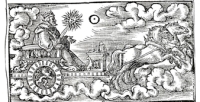 The Sun is the planet of reason as opposed to passion or appetite, the planet that never deviates in its orbit and speed, and is the giver of order to the remainder of the planets in the heavens. If the Knight’s Tale was simply a planetary allegory, Theseus’ role would be that of the Sun, but the story and its telling is more complex and pessimistic.
The Sun is the planet of reason as opposed to passion or appetite, the planet that never deviates in its orbit and speed, and is the giver of order to the remainder of the planets in the heavens. If the Knight’s Tale was simply a planetary allegory, Theseus’ role would be that of the Sun, but the story and its telling is more complex and pessimistic.
In his behavior and decisions Theseus seems not at all like the kingly Sun, although he keeps up those appearances. If we want to look at the true planetary influences embodied by him, we find ourselves instead with the malefics Mars and Saturn. Here are some examples.
We first hear from Theseus when his royal procession home stopped by the women in mourning. He greets them in a self-absorbed but entirely common (and not sunlike) way.
‘What folk been yet, that at myn hoom-comingye
Perturben so me feste with cryinge?’
Quod Theseus, ‘have ye so greet envye
Of myn honour, that thus compleyne and crye?
Or, who hath yow misboden (insulted or injured), or offended?
And telleth me if it may been amended;
And why that ye been clothed thus in blak?’ ( ll.47-53)
These are the words not of an idealized solar king but one whose first impulse is small-minded who later recovers his ways. Initially Theseus is irritated at the inconvenience of his moment of triumph being interrupted by these women. Upon hearing from the women, he was moved at their pitiable condition “that whilom weren of so greet estate” (l. 98); his justification for marching on Thebes was more from his outrage the reversal of fortune of these noble women than avenging Creon’s injustice. (In Book XII of the Thebiad, Statius casts Theseus in a more idealized light than does Chaucer.)
Under the banner of Mars, the god of war and a flag of the Minotaur, Theseus and his soldiers march on Thebes. After killing Creon he took the city, “and rente adoun both wal, and sparre (both), and rafter” – Theseus had much of it destroyed. On the next day, when his soldiers were robbing the corpses of their armor and clothes, they found Arcite and Palamon. (In Boccaccio’s version, the men were looking over the corpses for their own dead. They discovered the two men, approached them humbly and sought medical care for them.[21]) Indeed Chaucer’s depictions of the actions of war may have been common in his era, yet they certainly may be questioned as to their goodness or wisdom. Theseus does not manifest as an idealized solar ruler but has harnessed the malevolent planet of war.
The decision about imprisoning the two Theban knights has more the symbolism of the planetary malefic Saturn than of the kingly Sun, since he confines them without hope for freedom. Later, Palamon’s tears made the fetters on his shins wet (ll. 421-422), as he “perpetuelly is dampned (condemned, doomed) to prisoun,/In cheynes and in fetters to been deed…” (ll. 484-485). It is difficult not to escape the symbolism of the astrological Saturn here.
(In the Teseida, Boccaccio had Theseus stipulate that Arcite and Palamon be treated well, to have their basic needs taken care of.[22])
Theseus’ associations with the astrological malefics continue. In the scene at the grove, Theseus invokes Mars twice to stop the fight and to decree that Arcite and Palamon be executed. He first tells them to stop fighting or, “by mighty Mars”, he will decree that they lose their heads. Then, after Palamon tells the Duke who they are, that one has been forbidden to return to Athens and the other escaped from his jail, he commands them to be executed immediately (since there is no need for torture to get information from them) and again invokes Mars – until the women’s pleas begin to change his mind.
At this point Theseus’ actions finally take on more of a solar character. The huge stadium created by Theseus looks strikingly like the world (including the heavens) in miniature. It is a mile around made of stone and surrounded by a ditch, and a height of sixty feet. More like the Christian deity than the absent god Jupiter, Chaucer’s Theseus has created an imitation of the world. Indeed, the morning of the great contest, he “at a window set/Arrayed right as he were a god in trone.” (1671). Later, using solar symbolism, we see that Theseus leads a procession through Athens to the stadium, all is decked with gold and he is seated in a high and central place with others arrayed around him “in degrees”. This is like a king a court but it is also like many visual and literary representations of God in heaven. In the southern direction, Theseus is also in the place of the Sun’s culmination in the northern hemisphere.
Yet, if we consider the cardinal directions of the stadium to be like the cardinal signs of the zodiac, Theseus’ position is that of Saturn. Using the planets ruling the cardinal signs of the zodiac, we get Venus, Mars, and Moon, for Libra, Aries, and Cancer respectively. That leaves Saturn at the south gate as the ruler of Capricorn.
Theseus may be seated like a god in his throne but his world still tends toward chaos and violence: this solar god cannot contain his creation. Theseus has commanded that all knights in battle here dispose of their most dangerous weapons, and that nobody dies. Yet the earlier lengthy depictions of the leaders of Palamon’s and Arcite’s knights, the Saturn-like Ligurge (Lycurgus), and the Mars-like Emetreus (1270-1331), hints that the action here would be brutal. Even after the contest has ended and Arcite declared the winner, the victor’s great moment is suddenly shattered by falling from his horse. This continues to be the way of this world.
Let’s return to the end of the story. Years after Arcite’s fatal injury and his grand funeral, the story culminates with the Duke’s speech to Palamon, Emilye, and Parliament. In Boccaccio’s account, Theseus’ speech was held only a few days after Arcite’s funeral, and was to follow up dying Arcite’s explicit request that Palamon and Emilye marry. Instead, Chaucer has maximized the distance between the pathos of Arcite’s funeral and Theseus’ speech.
Chaucer precedes Theseus’ speech by two shorter ones that stand in strong contrast to one another and, in different ways, set up Theseus’ final speech. Chaucer reserves the most moving lines of the Knight’s Tale for Arcite’s deathbed speech, where the dying knight bemoans the futility of our many worldly cares, speaks generously of Palamon, and tells Emilye that she should consider Palamon if she should marry (1907-1939). At his moment of death Arcite appears to be raised above his star and deity Mars, yet in the following words the narrator knows not where this man’s soul will go in heaven but asks Mars to take him there.[23]
Years later the Duke and Parliament has summoned Emilye, Palamon in a grand assembly with Parliament. Here Theseus is again like a god on his throne. Theseus was silent for a time but then he “seyed his wille” in a long speech of 106 lines (ll. 2129-2235).
The Duke begins grandly but his discourse becomes more self-serving as it moves toward its conclusion. He begins cosmically by invoking the “first moevre” who is the first cause, who “made the faire cheyne of love”. His next words, however, seem not about love but more about chains: the first moevre has set the limits of the places of the elements and the duration of periods of time, all to stabilize “this wretched world”. Theseus then says that although providence rules our world, all things become corrupt and die away. Theseus recounts that great trees, rivers, and towns all decay eventually, all people come to die, and all this is caused by “Jupiter the king, the proper source of everything.” Therefore we must accept what is necessary and if we complain against the order of the world that is rebellion.
He then talks of Arcite who “dyen in his excellence and his flour”: Arcite is, according to Theseus, a fortunate man because he died at the height of his fame and honor. (From his deathbed years before, Arcite would vigorously disagree.) Instead of continuing to mourn Arcite’s death we should thank Jupiter for his divine grace.
Theseus then pronounces his edict: Emilye will marry Palamon. He speaks to her directly, referring to Palamon as her knight and servant who had endured great adversity for her. “Lat see now some of your wommanly pittee” (l. 2225), he says. Emilye says nothing, of course. (She does in Boccaccio’s version although the outcome is the same.) Theseus then turns to Palamon, says “ther nedith litel sermoning/ To make yow assente to this thing.” (ll. 2233-4) Theseus then asks Palamon to take Emilye by the hand, and the Knight’s Tale ends happily for all.
Theseus’ speech, its grand setting and pageantry that echoes the grandness of the stadium and of the tournament, gives Theseus the appearance of Sun-like power and leadership. At bottom it is much more an exercise in realpolitik. The august setting and speech constitutes a grandiloquent saturnine apology for the established hierarchy and temporary expedience.
Theseus’ sun-like status and posturing are not borne out by reality, yet the job of a king (or duke, in this case), is to maintain a sun-like regal presence. Is true solar leadership possible in this world? Chaucer’s Knight appears to have some real doubts about this, since the nature of conflict and the needs of the state tend a ruler not toward solar but martian and saturnine behavior. Additionally, being a leader tends to make oneself pretentious and self-absorbed, as we see in the character of Theseus. From the point of view of Chaucer’s Knight who must command in battle, these are grave matters.
Notable is the absence of Jupiter, the king of the Olympian gods and the great benefic of astrology’s traditional planets. Recall that on Olympus, Jupiter could not solve the disagreement between Venus and Mars. Arcite prays that Jupiter guide his soul in the afterlife, yet the narrator asks Mars to guide this soul to his final place. Theseus, in his final speech, cites Jupiter as the “cause of everything”, to whom we should feel grateful in the light of tragedy. In the Knight’s bleak universe it is not Jupiter but Saturn who is in charge; our “wretched world” is governed not by the great benefic but the great malefic, and the Christian God seems very far away.
According to the medieval view, Jupiter is the planet of generosity, moderation and one’s social and cultural milieu. In the absence of the Sun as a planet of leadership, Jupiter would do. Instead Chaucer gives us a world dominated by Saturn.
Marc Guidry refers to this in his discussion of the council of the gods before the tournament: “In Chaucer’s vision, Jovian justice (in the Virgilian sense) is absent from the gods’ consult: it is replaced by Saturnian expediency, which allows Palamon and Arcite to indulge the concupiscence and wrath represented by their tutelary deities, Venus and Mars, without concern for the needs of Thebes or Emily, whose interests to unrepresented at the proceedings.”[24] This “concern” is the nature of the astrological Jupiter who is powerless in the Knight’s Tale except as a vain aspiration.
This returns us to the Knight’s pilgrimage, his journey of penitence (and hopefully reconciliation) to his Christian God. The bleakness of the Knight’s Tale lets us know how little faith in the goodness of the world – and the goodness of God – remains with the virtuous warrior recently returned from battle. The Knight has not a moment to spare for his salvation.
It is fitting that the Knight’s Tale is the first of the Canterbury Tales and is at the beginning of the pilgrimage. The Miller, much lower in rank, reputation, and behavior than the Knight, has a fitting “quit” or reply. The Miller’s Tale is not a ponderous questioning of the goodness of God and the world but a celebration of human flesh, frailty, and even stupidity. At its base, the Miller’s world is joyful one, a better world than we are given by the Knight.



